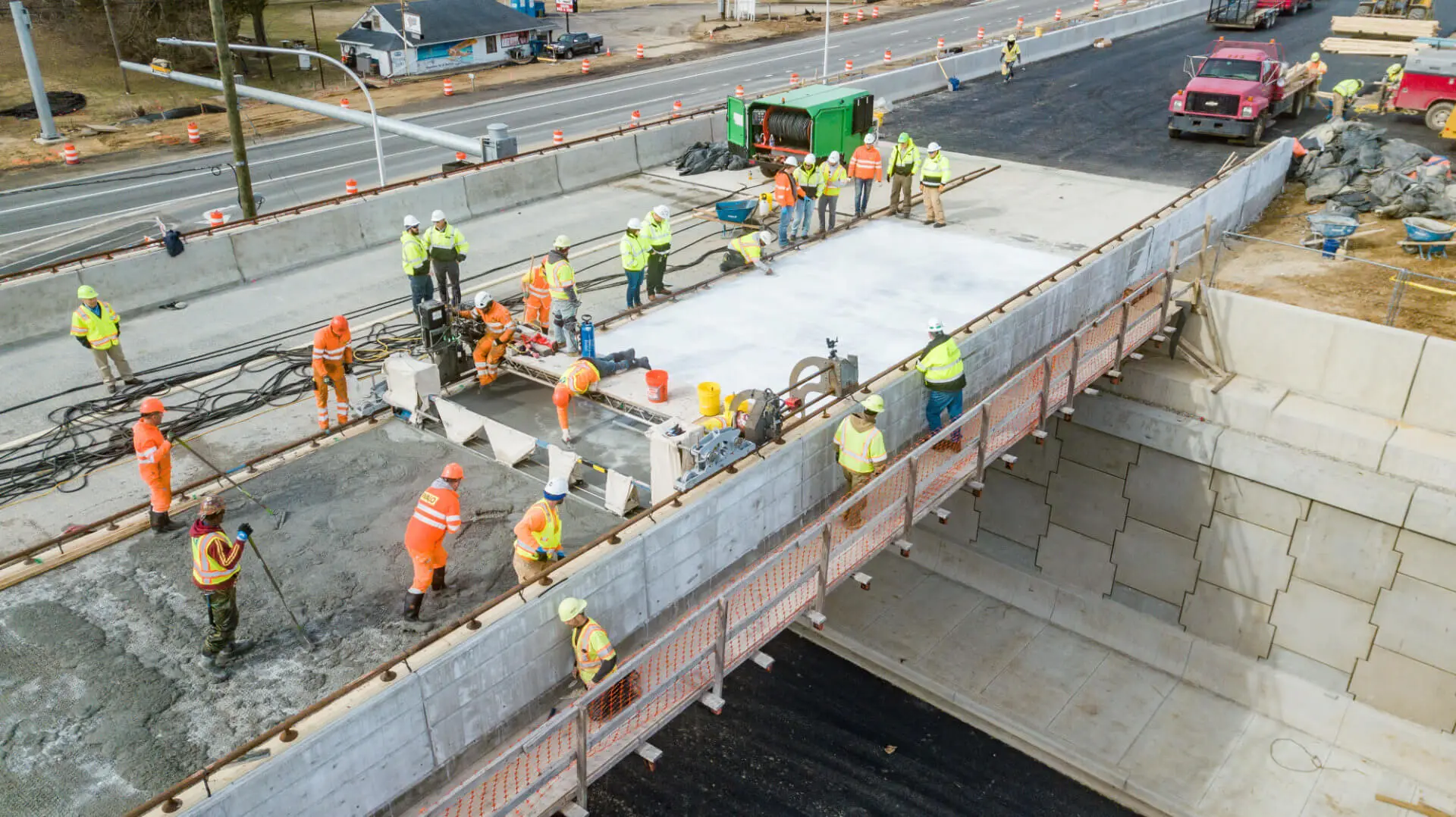Steps on How to Construct a Road
Building a road is a complex process that involves a series of carefully orchestrated steps, from the initial planning stages to the final paving and finishing touches.
1. Prepping the Ground (Earthwork)
Think of this as laying the groundwork, literally! It’s all about getting the terrain ready for the road ahead.
- Grading and Sloping: The ground is shaped using powerful machines to create a smooth surface with gentle slopes. This ensures rainwater naturally flows off the road, preventing puddles and potential damage.
- The Foundation (Sub-Base): A sturdy layer of crushed stone or gravel, known as the sub-base, is laid down. This crucial layer provides stability, preventing the road from sinking or shifting under the weight of traffic.
2. Building a Strong Base (Base Construction)
With the foundation set, it’s time to build the road’s backbone—a robust base layer that can handle the load.
- Load-Bearing Champion (Base Course): A thick layer of material, typically crushed rock, is spread to act as the primary load-bearing component. This layer absorbs the weight of vehicles, preventing cracks and damage to the smoother top layers.
- Compaction is Key: Heavy rollers compact the base course, squeezing out air pockets and creating a dense, durable surface. This step is vital for even weight distribution and proper drainage, ensuring the road’s long-term performance.
3. The Finishing Touch (Surface Course)
This stage transforms the rough base into a smooth, drivable surface—the part we all interact with.
- Asphalt or Concrete?: The choice between asphalt (that black, smooth stuff) or concrete depends on factors like traffic load and budget. Both materials offer excellent wear resistance and provide a satisfyingly smooth ride.
- Laying it Down: Machines with heated beds carefully lay the chosen material, ensuring uniform thickness and a seamless finish. This process requires precise coordination between human expertise and sophisticated machinery.
4. Adding the Finishing Touches
A road needs more than just a surface; it requires safety features and aesthetic elements to function effectively and blend into the environment.
- Staying Safe on the Road: Road markings, traffic signs, and other safety features are installed. Think lane dividers, crosswalks, and reflective markers that guide drivers at night, ensuring the safety of all road users.
- Aesthetics Matter: Landscaping, noise barriers, and even decorative lighting can be incorporated. These touches enhance the road’s visual appeal while also improving the driving experience and minimizing environmental impact.
5. Embracing Modern Techniques
Road construction constantly evolves, incorporating innovative techniques for increased efficiency, sustainability, and safety.
- Going Green: Recycled materials and eco-friendly construction practices are becoming increasingly important. Minimizing the environmental footprint of road construction ensures a healthier planet for future generations.
- Technology at Work: Drones capture aerial data for precise mapping, while GPS-guided machinery enables accurate grading and paving. These technologies enhance efficiency, reduce errors, and optimize resource usage.
- Different Roads, Different Needs: From highways to residential streets, each road type has unique construction requirements. Factors like traffic volume, speed limits, and climate play a crucial role in material selection and design.
Building a road is a testament to human ingenuity and collaboration. It’s a complex process that requires careful planning, meticulous execution, and a commitment to safety and sustainability.
Planning Your Road: What Are The First Steps?
Before breaking ground, thorough planning is crucial for a successful road construction project.
1. Size Up the Situation: Assessment and Planning
Before any construction can begin, a comprehensive understanding of the project’s scope and potential impact is essential.
- Purpose and Functionality: What is the primary reason for building this road? Is it connecting two towns, providing access to a new development, or offering a scenic route? Clearly defining the road’s purpose helps shape all other planning decisions.
- Environmental Impact: Analyzing the road’s potential effects on the local ecosystem is crucial. This includes considering the impact on plants, animals, water sources, and air quality. It’s vital to minimize the environmental footprint and implement sustainable practices throughout the construction process.
- Budgetary Considerations: Building a road is a significant investment. Creating a realistic budget that considers all aspects of the project, from land acquisition to materials and labor, helps prevent costly overruns and ensures the project’s financial feasibility.
2. Prep the Runway: Site Preparation
Transforming the site from a blank slate into a construction zone is the next critical phase.
- Secure the property: Just like any construction project, ensuring clear ownership or legal access to the land where the road will be built is paramount. This prevents legal disputes and ensures a smooth construction process.
- Clear the way: Trees, bushes, rocks – anything in the path of the proposed road needs to be cleared. This might involve tree removal, demolition of existing structures, and removal of large rocks or debris. Think of it as preparing a clean canvas for the construction masterpiece.
- Shape the land: Earthmoving equipment will be brought in to create proper drainage and ensure the ground is stable. This might involve excavating and filling areas to achieve the desired elevation and slope of the roadbed.
3. Pick the Perfect Ingredients: Material Selection
Choosing the right materials for each layer of the road is crucial for its durability, longevity, and performance.
- Subgrade: This is the foundation of the road. Strong, stable materials that can handle the weight of the road and traffic are essential. Geotechnical investigations help determine the appropriate subgrade material and compaction requirements.
- Sub-base and Base: These layers provide additional strength and stability, distributing the weight of traffic evenly. Crushed stone, gravel, and other aggregates are commonly used in these layers, with specific gradations selected for optimal performance.
- Asphalt: This smooth, black top layer provides a durable and skid-resistant surface for vehicles. The type of asphalt used will depend on factors like traffic volume, climate, and expected load conditions.
4. Bring in the Experts: Skilled Execution
With the groundwork laid and materials selected, it’s time to bring in skilled construction crews and specialized equipment.
- Excavation: This involves digging out the roadbed to the required depth and preparing the foundation according to the design specifications.
- Grading: Shaping the road to the correct elevation and slope ensures proper drainage and a smooth driving surface.
- Paving: This crucial step involves laying down the asphalt or concrete surface course using specialized paving machines. Achieving a uniform thickness and a seamless finish requires precision and expertise.
- Finishing: Adding those final touches, like lane markings, signage, and guardrails, enhances safety and guides traffic flow.
5. Keep it Running Smoothly: Maintenance and Repairs
Building a road is a long-term investment, and regular maintenance is crucial to extend its lifespan and ensure its safety.
- Regular check-ups: Periodic inspections help identify potential problems like cracks, potholes, or drainage issues before they escalate into major concerns.
- Quick fixes: Addressing minor issues promptly prevents further deterioration and more costly repairs down the line.
- Long-term care: Over time, sections of the road might need to be repaved, resurfaced, or reinforced to address wear and tear and maintain optimal performance.
Building a road is a big undertaking, but by taking it step-by-step and working with experienced professionals, we can create a safe and durable road that will serve us well for years to come.
Getting Down To Earth: Site Preparation and Earthworks
Site preparation and earthworks are foundational to any road construction project, ensuring a solid, stable, and well-drained base for the road ahead.
Clearing the Slate: Initial Site Clearance
Before any earthmoving can begin, the site needs to be cleared of any obstructions:
- Vegetation Removal: Trees, shrubs, and other vegetation within the road’s proposed alignment are removed.
- Demolition and Removal: Existing structures, pavement, or utilities that interfere with the road’s construction are demolished and removed from the site.
- Clearing and Grubbing: The topsoil and any unsuitable material are removed and properly disposed of or stockpiled for later use in landscaping or other areas.
Understanding the Ground Beneath: Soil Investigation
Before building anything, understanding the characteristics of the soil is essential:
- Soil Testing: Samples are taken and analyzed to determine the soil’s bearing capacity, composition, and drainage properties.
- Subgrade Evaluation: This analysis determines if the existing soil is suitable to support the road or if it needs to be improved through compaction, stabilization, or replacement with more suitable material.
Shaping the Landscape: Earthmoving Operations
With a clear understanding of the site and soil conditions, earthmoving can begin:
- Excavation: Excavation involves digging out or removing earth to achieve the desired grade and elevation for the roadbed. This might involve cutting into hillsides, filling in depressions, or creating trenches for drainage structures.
- Filling: Filling is the process of placing and compacting soil or other materials to raise the elevation of the roadbed.
- Grading and Sloping: This step involves shaping the earth to create a smooth and even surface with the proper slopes for drainage. This ensures that water flows away from the road surface, preventing ponding and potential damage.
- Compaction: Compaction is crucial for creating a dense and stable base for the road. Heavy equipment, like rollers and compactors, are used to compress the soil, reducing its volume and increasing its load-bearing capacity.
Proper site preparation and earthworks are essential for preventing future problems:
- Settling and Cracking: Poorly compacted soil can settle over time, leading to cracks, potholes, and uneven pavement. Proper earthworks help prevent these issues, increasing the road’s lifespan and reducing maintenance costs.
- Drainage Issues: Inadequate drainage can lead to water damage, erosion, and even road failures. Site preparation ensures proper drainage by grading the roadbed to direct water away from the pavement and into appropriate drainage systems.
Taking the time for thorough site preparation and earthwork sets the stage for a durable and long-lasting road.
Building The Foundation: Base Layer Construction For Roads
A road’s base layer is its hidden strength, providing the essential support and drainage system for the pavement above.
Why a Strong Base Layer Matters
- Load Distribution: A well-compacted base layer distributes the weight of vehicles evenly over the subgrade, preventing localized stress points that can lead to cracking and deformation of the pavement.
- Drainage: The base layer plays a vital role in draining water away from the pavement, preventing water damage, frost heave, and weakening of the road structure.
- Stability: A strong base layer minimizes the impact of traffic loads and environmental factors, contributing to a longer lifespan for the road and reducing the need for frequent maintenance.
Constructing the Base Layer: A Step-by-Step Guide
- Subgrade Preparation: The process begins with a well-prepared subgrade—the compacted soil layer upon which the base layers are built.
- Geotextile Installation (Optional): In some cases, a geotextile fabric is placed on top of the subgrade. This permeable fabric prevents the aggregate base material from mixing with the underlying soil, ensuring proper drainage and preventing contamination of the base layer.
- Spreading and Compacting the Sub-Base: The sub-base layer, typically consisting of crushed stone, gravel, or recycled aggregates, is spread evenly over the prepared subgrade or geotextile. This layer is then compacted to the required density, ensuring a stable foundation for the next layer.
- Spreading and Compacting the Base Course: The base course, often composed of higher-quality aggregates, is placed on top of the compacted sub-base. This layer is again compacted to the specified density, providing additional strength and load-bearing capacity.
Material Selection: Choosing the Right Aggregates
The type of aggregate used in the base layers depends on factors such as:
- Traffic Load: Roads subjected to heavy traffic require stronger aggregates with higher load-bearing capacities.
- Drainage Requirements: The aggregate’s permeability influences its ability to drain water effectively.
- Local Availability: Using locally sourced materials can reduce transportation costs and minimize the project’s carbon footprint.
A well-constructed base layer is crucial for a road’s longevity, performance, and resilience.
## Source
Have you ever wondered about the road construction wiki? Understanding the step by road construction process is essential for any construction project. You can also check out various construction project profile examples for inspiration and guidance.
- Black Backsplash With White Cabinets: A Bold Kitchen Design - November 5, 2025
- Black and White Kitchen Backsplash: Ideas for Timeless Style - November 4, 2025
- Kitchen Backsplash Ideas: Fresh Looks to Upgrade Your Space - November 1, 2025










